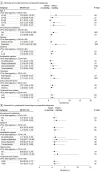Functional and Safety Outcomes of Carotid Artery Stenting and Mechanical Thrombectomy for Large Vessel Occlusion Ischemic Stroke With Tandem Lesions
- PMID: 36857054
- PMCID: PMC9978940
- DOI: 10.1001/jamanetworkopen.2023.0736
Functional and Safety Outcomes of Carotid Artery Stenting and Mechanical Thrombectomy for Large Vessel Occlusion Ischemic Stroke With Tandem Lesions
Abstract
Importance: Approximately 10% to 20% of large vessel occlusion (LVO) strokes involve tandem lesions (TLs), defined as concomitant intracranial LVO and stenosis or occlusion of the cervical internal carotid artery. Mechanical thrombectomy (MT) may benefit patients with TLs; however, optimal management and procedural strategy of the cervical lesion remain unclear.
Objective: To evaluate the association of carotid artery stenting (CAS) vs no stenting and medical management with functional and safety outcomes among patients with TL-LVOs.
Design, setting, and participants: This cross-sectional study included consecutive patients with acute anterior circulation TLs admitted across 17 stroke centers in the US and Spain between January 1, 2015, and December 31, 2020. Data analysis was performed from August 2021 to February 2022. Inclusion criteria were age of 18 years or older, endovascular therapy for intracranial occlusion, and presence of extracranial internal carotid artery stenosis (>50%) demonstrated on pre-MT computed tomography angiography, magnetic resonance angiography, or digital subtraction angiography.
Exposures: Patients with TLs were divided into CAS vs nonstenting groups.
Main outcomes and measures: Primary clinical and safety outcomes were 90-day functional independence measured by a modified Rankin Scale (mRS) score of 0 to 2 and symptomatic intracranial hemorrhage (sICH), respectively. Secondary outcomes were successful reperfusion (modified Thrombolysis in Cerebral Infarction score ≥2b), discharge mRS score, ordinal mRS score, and mortality at 90 days.
Results: Of 685 patients, 623 (mean [SD] age, 67 [12.2] years; 406 [65.2%] male) were included in the analysis, of whom 363 (58.4%) were in the CAS group and 260 (41.6%) were in the nonstenting group. The CAS group had a lower proportion of patients with atrial fibrillation (38 [10.6%] vs 49 [19.2%], P = .002), a higher proportion of preprocedural degree of cervical stenosis on digital subtraction angiography (90%-99%: 107 [32.2%] vs 42 [20.5%], P < .001) and atherosclerotic disease (296 [82.0%] vs 194 [74.6%], P = .003), a lower median (IQR) National Institutes of Health Stroke Scale score (15 [10-19] vs 17 [13-21], P < .001), and similar rates of intravenous thrombolysis and stroke time metrics when compared with the nonstenting group. After adjustment for confounders, the odds of favorable functional outcome (adjusted odds ratio [aOR], 1.67; 95% CI, 1.20-2.40; P = .007), favorable shift in mRS scores (aOR, 1.46; 95% CI, 1.02-2.10; P = .04), and successful reperfusion (aOR, 1.70; 95% CI, 1.02-3.60; P = .002) were significantly higher for the CAS group compared with the nonstenting group. Both groups had similar odds of sICH (aOR, 0.90; 95% CI, 0.46-2.40; P = .87) and 90-day mortality (aOR, 0.78; 95% CI, 0.50-1.20; P = .27). No heterogeneity was noted for 90-day functional outcome and sICH in prespecified subgroups.
Conclusions and relevance: In this multicenter, international cross-sectional study, CAS of the cervical lesion during MT was associated with improvement in functional outcomes and reperfusion rates without an increased risk of sICH and mortality in patients with TLs.
Conflict of interest statement
Figures



References
-
- Pires Coelho A, Lobo M, Gouveia R, et al. . Overview of evidence on emergency carotid stenting in patients with acute ischemic stroke due to tandem occlusions: a systematic review and meta-analysis. J Cardiovasc Surg (Torino). 2019;60(6):693-702. - PubMed
Publication types
MeSH terms
Grants and funding
LinkOut - more resources
Full Text Sources
Medical

